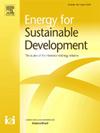Optimizing battery energy storage and solar photovoltaic systems for lower-to-middle-income schools amidst load-shedding
IF 4.9
2区 工程技术
Q2 ENERGY & FUELS
引用次数: 0
Abstract
Energy reliability and cost efficiency are critical challenges for lower-to-middle-income schools in developing regions, where frequent power outages hinder academic activities and strain finances. This study presents a robust methodology to determine the optimal size of the photovoltaic (PV) system coupled with battery storage, under two distinct demand scenarios: “stable” and“intermittent”. The stable scenario assumes consistent year-round demand, while the intermittent scenario models 50% demand during load-shedding periods.
A proposed Unified Rule-Based (URB) scheduling approach was evaluated across different electricity pricing schemes. Optimal PV sizes managed with the URB strategy achieved up to 22% lifetime savings, reduced total energy demand by 47%, and peak-hour demand by 63%, while supporting 98% of the load-shedding requirements. This approach offers a scalable and practical solution for improving energy reliability, reducing costs, and enhancing environmental sustainability in low-income educational institutions. The findings underscore the effectiveness of the URB strategy and provide actionable insights for future policy implementations and the advancement of climate-neutrality targets.
优化中低收入学校的电池储能和太阳能光伏系统
能源可靠性和成本效率是发展中地区中低收入学校面临的关键挑战,在这些地区,频繁的停电阻碍了学术活动,并使资金紧张。本研究提出了一种强大的方法来确定光伏(PV)系统与电池存储相结合的最佳尺寸,在两种不同的需求情景下:“稳定”和“间歇性”。稳定情景假定全年需求一致,而间歇情景假定在减载期间需求为50%。在不同的电价方案下,对一种基于统一规则的调度方法进行了评价。采用URB策略管理的最佳PV尺寸实现了高达22%的寿命节约,减少了47%的总能源需求,高峰时段需求减少了63%,同时支持98%的减载需求。这种方法为提高低收入教育机构的能源可靠性、降低成本和增强环境可持续性提供了一种可扩展和实用的解决方案。研究结果强调了城市城市战略的有效性,并为未来的政策实施和气候中和目标的推进提供了可操作的见解。
本文章由计算机程序翻译,如有差异,请以英文原文为准。
求助全文
约1分钟内获得全文
求助全文
来源期刊

Energy for Sustainable Development
ENERGY & FUELS-ENERGY & FUELS
CiteScore
8.10
自引率
9.10%
发文量
187
审稿时长
6-12 weeks
期刊介绍:
Published on behalf of the International Energy Initiative, Energy for Sustainable Development is the journal for decision makers, managers, consultants, policy makers, planners and researchers in both government and non-government organizations. It publishes original research and reviews about energy in developing countries, sustainable development, energy resources, technologies, policies and interactions.
 求助内容:
求助内容: 应助结果提醒方式:
应助结果提醒方式:


